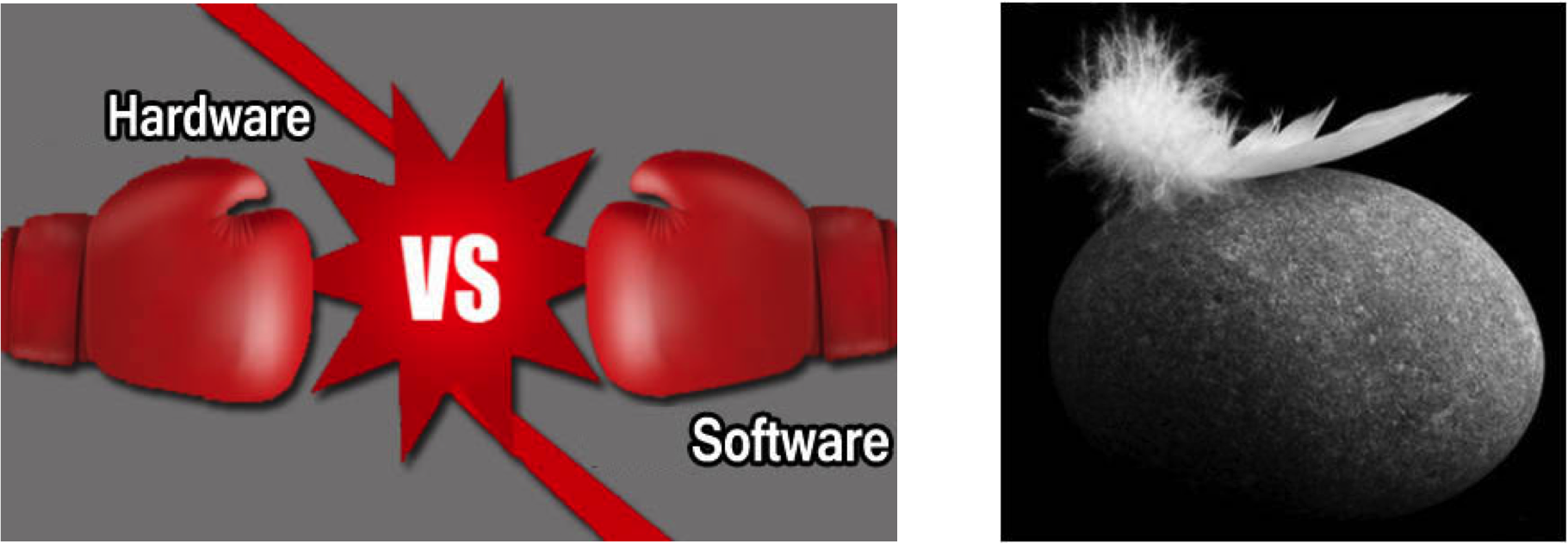 An OpenStack cloud has a lot of virtual features. Almost every piece of hardware has been virtualized and this makes me think that a cloud is a very "soft" system.
An OpenStack cloud has a lot of virtual features. Almost every piece of hardware has been virtualized and this makes me think that a cloud is a very "soft" system.
Hubs, switches, routers, interfaces/ports, line cards, gateways, servers, firewalls, wires/cables/bus, motherboards, keyboard, mouse, memory/RAM, processor/CPU, hard drive/ROM, PCI slots, power switches -- All of these have a virtualized version in an OpenStack cloud! They are no longer things that we un-box and install. They are all virtual, software-based, Pythonic Linux processes!
Luckily, they have not virtualized CPU heatsinks, headphones, LCD projectors, power source, antennas, server chassis, laptop cases, web cameras and DVD/Blu-ray players yet!
As much as companies in the fields of software, networking, cloud, SDN, NFV and telecom are trying very hard to virtualize everything, I see that there is also an equal effort to use great hardware to replace virtualization in the cloud industry.
In today's cloud and data center industry, there is clearly a great amount of competition between software and hardware, between virtualization and bare metal. "Bare metal" are the buzzwords and they have become very famous cloud jargons. No more "bare" software! 
Below are a few relevant diagrams.



"It is virtually impossible to virtualize everything". Right ? There is clearly a war between virtualization and bare metal. We all know who wins when there is a war between software and hardware.
Below are the different bare metal technologies that replace virtualized features in an OpenStack cloud. The advantages of bare metal technologies over virtualized features are:
- High performance
- Very high scalability
- High throughput
- Large number of parallel processes
- Very high processing speed
- 100% Dedicated resources (CPU, memory, cache, hard disk, networking ports)
- OpenStack Ironic provisions a bare metal physical server that replaces a virtual machine.
- SR-IOV (supported by Intel and Mellanox cards) and Cisco's VM-FEX extend a physical network adapter directly to a virtual machine bypassing the layer-2 virtual switch (Open vSwitch or Linux Bridge).
- Cisco's ASR 1000 Series Router (ASR1K) plugin can be used to do layer-3 forwarding in OpenStack Neutron and replace Neutron's virtual router (that uses neutron-L3-agent and NAT software) with Cisco's ASR1k.
- Cisco's CPNR (Cisco Prime Network Registrar) plugin can be used with Neutron to replace dnsmasq (virtual DHCP and DNS server in Neutron) with a highly-scalable physical DHCP and DNS enterprise server. The CPNR Neutron plugin has been open-sourced by Cisco on GitHub.
- Cisco's Nexus driver for Neutron can be used to replace neutron's virtual router and virtual layer-2 switch and do layer-2 switching and layer-3 forwarding on a physical Nexus switch (N3k, N5k, N6k, N7k and N9k).
- Cisco's APIC plugin for Neutron can be used to replace neutron's virtual router and virtual layer-2 switch and do layer-2 switching and layer-3 forwarding on Cisco's physical ACI (Application Centric Infrastructure) fabric that uses UCS and Nexus 9000.
- Linux containers and Docker containers can be created on a bare metal physical server with no hypervisor, no virtual machine and no virtual layer-2 switch.
- Neutron's provider networks can be used to do layer-2 switching and layer-3 forwarding on a physical switch and a physical router respectively, and thereby bypassing Neutron's virtual gateway, virtual router and the virtual layer-2 switch.
- NAT hardware acceleration can be used to replace Neutron's NAT software and iptables with a physical layer-3 device.
- SDN and OpenDaylight can be integrated with OpenStack to "virtually" use any bare metal physical device that supports REST/OpenFlow in the cloud.
As far as NFV (Network Functions Virtualization) is concerned, using bare metal technologies is completely the opposite of NFV ("un-NFV" or "NFun-V" ?  ).
).
Below is a table that shows what is "in" and what is "out" when we "un-virtualize" the cloud.
| OUT | IN |
|---|
| Virtual machine | Ironic provisioning a bare metal server |
| Virtual layer-2 switch (Open vSwitch or Linux Bridge) | SR-IOV |
| Virtual layer-2 switch (Open vSwitch or Linux Bridge) | VM-FEX |
| Neutron's virtual router (neutron-L3-agent and NAT software) | Cisco's ASR 1000 Series Router (ASR1K) plugin |
| Neutron's virtual DHCP and DNS server (dnsmasq) | Cisco's CPNR (Cisco Prime Network Registrar) plugin |
| Neutron virtual router and virtual layer-2 switch | Cisco's Nexus driver for Neutron |
| Neutron virtual router and virtual layer-2 switch | Cisco ACI fabric (UCS and Nexus 9000) |
| Containers on virtual machine using hypervisor and virtual layer-2 switch | Containers on bare metal physical server |
| Neutron's virtual router and virtual gateway | Neutron's provider networks |
| Neutron's NAT software and iptables | NAT hardware acceleration |
| Low performance, reduced scale limit, low throughput and slow processing | High performance, high scale limit, high throughput and fast processing |
| Shared resources (CPU, memory, cache, hard disk, networking ports) | 100% dedicated resources (CPU, memory, cache, hard disk, networking ports) |
| Cost-effective cloud | Expensive cloud |
| Small network topology | Large network topology |
| Cloud that is built quickly | Cloud that needs more time to build |
| Minimum hardware expertise | Lot of hardware expertise |
| Less hardware to maintain | More hardware to install and maintain |
| Less power usage | More power usage |
| Environmentally friendly | Not environmentally friendly
|
| Money | Great hardware |
As we clearly see in the the table above, using bare metal technologies to un-virtualize a cloud also has some disadvantages.
Do let me know if you virtualize or un-virtualize your cloud in the comments below!
